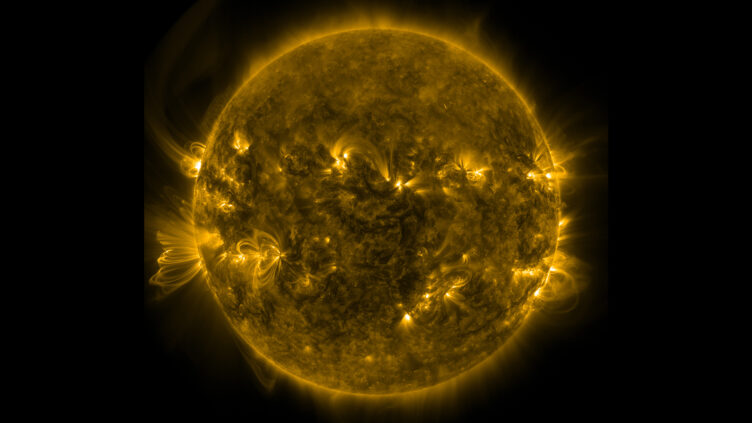Led by Instituto de Astrofísica e Ciências do Espaço researchers, the team made new magnetic measurements of β Hydri, a star analogous to the future Sun, to reveal surprising activity.
An international team1, led by Instituto de Astrofísica e Ciências do Espaço (IA2) researcher Ângela Santos, has made the first measurement of the magnetic field of β Hydri, a nearby aged solar analogue subgiant star. This result, published today in Astronomy & Astrophysics3, uncovered an unexpectedly strong magnetic braking, which supports the idea of a “born-again dynamo” in subgiant stars.
Ângela Santos (IA & Dep. of Physics and Astronomy of the Science Faculty of the University of Porto – DFA–FCUP), the lead author of this paper, says: “In recent years, we have discovered that the evolution of stellar magnetic activity is significantly more complex than previously thought. Studying solar-like stars, like β Hydri, particularly at different evolutionary states, is key to build a comprehensive picture of how stars and their systems age.”
β Hydri is one of the brightest stars visible to the naked eye in the southern sky, and one of the most studied stars besides the Sun. Slightly more massive than our star and further along in its life cycle, it has long been used as a model for understanding the Sun’s eventual evolution into a subgiant.
Despite its age, β Hydri shows signs of a magnetic activity cycle similar to that of the Sun—an unexpected feature for a star at this point in its evolution. The team obtained high-precision spectropolarimetric data, using the HARPSpol instrument at the European Southern Observatory’s (ESO) 3.6-metre telescope in La Silla (Chile). These observations allowed, for the first time, a direct estimate of the star’s surface magnetic field.
“Our analysis shows that β Hydri is undergoing magnetic braking several times stronger than that of the Sun. This is a clear sign that the star hosts a large-scale dynamo, which is surprising for a subgiant.”
Ângela Santos
By combining this magnetic field measurement with stellar parameters derived from previous studies, including recent photometric data from NASA’s TESS space mission, the researchers calculated β Hydri’s current magnetic braking, the process by which a star loses angular momentum due to its magnetic wind.
This finding lends support to the emerging “born-again dynamo” scenario, in which subgiant stars—after a quieter magnetic phase typical of middle age—can experience a reactivation of magnetic activity as their outer layers expand.
“This kind of behavior challenges our conventional understanding of stellar magnetic evolution, and makes β Hydri a benchmark for testing and refining models of magnetic braking and dynamo evolution in old solar-like stars,” says Tiago Campante, leader of the Stellar Astrophysics Research Group at IA and professor at DFA-FCUP.
Co-author Ricardo Gafeira (IA & Faculdade de CIências e Tecnologia da Universidade de Coimbra – FCTUC) adds: “It also has implications for planetary environments because β Hydri seems to have reignited its magnetic engine, potentially increasing space weather hazards for any nearby planets.”
As the Sun’s elder twin, β Hydri offers a glimpse into the magnetic future of our own star and perhaps, a cautionary tale for any planets orbiting such “retired” suns.
The study highlights the scientific leadership of the IA in solar-stellar connection research, which involves different fields, combining stellar evolution, asteroseismology4, and magnetic field modelling.
Notes
- The team is: A. R. G. Santos, T. S. Metcalfe, O. Kochukhov, T. R. Ayres, R. Gafeira, and T. L. Campante.
- The Instituto de Astrofísica e Ciências do Espaço (Institute of Astrophysics and Space Sciences – IA) is the reference Portuguese research unit in this field, integrating researchers from the University of Lisbon, the University of Coimbra and the University of Porto, and encompasses most of the field’s national scientific output. It was evaluated as “Excellent” in the last evaluation of research and development units undertaken by Fundação para a Ciência e a Tecnologia (FCT). IA’s activity is funded by national and international funds, including FCT/MCES (UIDB/04434/2020 e UIDP/04434/2020).
- The article “Magnetic braking and dynamo evolution of β Hydri”, was published today in the journal Astronomy & Astrophysics (DOI: 10.1051/0004-6361/202554730)
- Asteroseismology is the study of stellar interiors by measuring seismic oscillations at the star’s surface, much like an echogram allows us to see the inside of our body. In seismology, the different vibration modes from an earthquake can be used to study the Earth’s interior, in order to get data from the composition and depth of its different layers. In a similar fashion, oscillations at the star’s surface can be used to infer its internal structure and composition. This and other stellar astrophysics subjects are discussed in an interactive App, aimed at non-specialists, available here.
Contacts
Ângela Santos, Tiago Campante, Ricardo Gafeira
Science Communication Group
Ricardo Cardoso Reis (Porto); Joana Saraiva (Lisbon); Filipe Pires (coordination)


